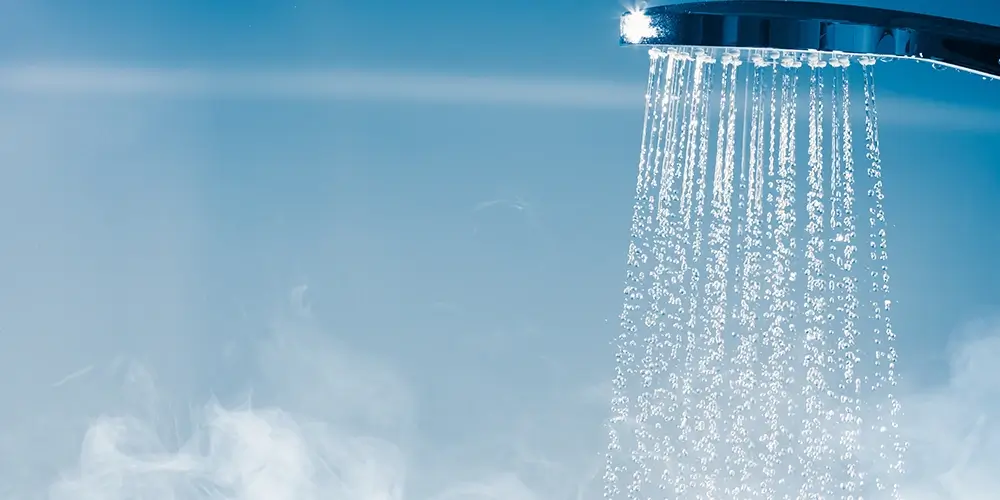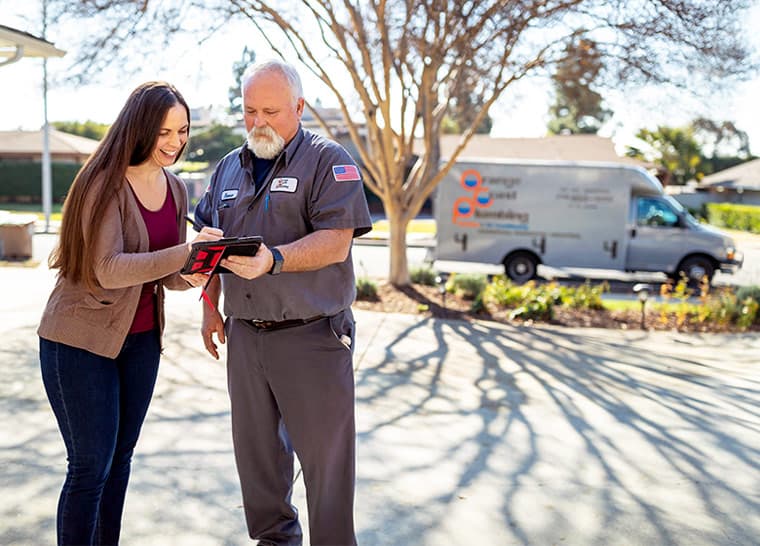Hot water is great for coffee, not baths.
Scalding hot tap water is dangerous, especially for children and seniors. 120 degrees Fahrenheit is the safety recommendation against scalding baths, but 140 degrees is the default setting on most water heaters.
Even 120 degrees is too warm for baths; anything over 111.2 degrees puts people and pets at risk. Steam from the bathwater or shower indicates you should turn it down a notch.
That seems easy enough — mix cold water with hot to prepare your bath. Problem solved, right?
Well, maybe, and maybe not. Because:
- Water that’s too hot from the tap is still a problem for young children and some seniors, who may lack the awareness to mix in cold water.
- Too-hot water is a waste — energy and money waste. You’re paying for excess heat.
- Too-hot water can be due to a faulty hot water thermostat that needs replacement.
- A malfunctioning water heater can burst! 69% of water heater failures result from a slow leak or sudden burst. Both problems can cause severe water damage; a bursting water heater is every bit as hazardous as it sounds.
Why the Water’s Too Hot
Now that you understand the gravity of the problem and have resolved to take action, a little DIY troubleshooting should put you on the path to safety.
We’ve determined that a water heater temperature setting, faulty thermostat, or malfunctioning water are the most likely reasons for too-hot water. Let’s go through the steps for each.
1. Incorrect Temperature Setting on Your Water Heater
Most experts agree that standing water below 120 degrees can be a breeding ground for bacteria like Legionella (which causes Legionnaire’s disease).
So 120 degrees is your water heater’s ideal temperature setting — warm enough to keep bacteria at bay and cool enough to prevent most scalding injuries.
Unfortunately, most water heaters have less-than-helpful low-to-high dials that don’t indicate exact temperatures, although they offer a scalding warning.
To get it right, you may have to make a series of adjustments, measuring the water temperature at the tap in your bathroom each time.
2. High Mineral Content in Water
Minerals in water can settle to the bottom of a tank as sediment, collect on a water heater’s heating element, and make the heater go cattywampus. Among other things, it will overheat.
This problem has an easy fix: flush your water heater or have a plumber do it as part of your annual plumbing checkup.
Some cities, including most in California, have notoriously hard water (high in minerals). If sediment in your hot water tank is recurring, you may need to install a water softener to reduce mineral content.
How to Flush a Water Heater
- Turn off the power source to your water heater.
- Turn off the cold water supply to your tank.
- Open the drain valve at the bottom of your tank and let out a few gallons of water.
- Close the drain valve and turn on the cold water supply again.
- Repeat this process once or twice until you notice sediment has cleared out from the tank.
- If sediment is still present, you may need to consider a professional cleaning service.
3. Faulty Water Heater Thermostat
If you’ve turned down the temperature dial on your water heater and flushed any sediment, but water temperatures remain too high, you may have a faulty thermostat.
We don’t recommend thermostat replacement as a DIY repair unless you’re incredibly handy, but we’ll take you through the steps.
How to Replace a Gas Water Heater Thermostat
The thermostat is part of the gas valve component in gas water heaters. You can’t replace a thermostat separately from this piece.
Natural gas is explosive and toxic. Even a tiny leak can be deadly, so again, we advise you to call a certified plumber or appliance repair technician for the job we’re outlining below.
- Locate the gas valve.
- Your water heater should list model information. Use this to look up the correct thermostat replacement parts — or you can find a universal valve and thermostat.
- Shut off the gas.
- Turn off the gas line to the water heater, ensuring the valve is perpendicular to your gas line. Remember that this is different from your gas valve on/off switch.
- Wait for the water to cool. It may take a few hours.
- Unhook the lines that connect to your gas valve. These may include the gas line, thermocouple, pilot light supply line, and main burner supply line. Depending on your model, you may also have an electronic igniter to unhook.
- Replace the gas valve per the manufacturer’s instructions.
- Make sure you get a tight fit! Anything less invites a gas leak. Teflon tape may help to secure the connection.
- Refill your water tank.
- Close your drain valve and turn on the water supply. Once some water drains, you can close the pressure relief valve and open a hot water faucet to release the air from the tank and lines.
- Re-install the lines that connect to your gas valve.
- Set the gas valve to off. Then, after you’ve tightened everything, check for leaks. Turn on the gas line to your water heater; apply soapy water to the gas valve. A leak will cause more bubbles to form.
- Finally, you can light the pilot. Your new gas valve should have instructions to help you through these steps.
4. Malfunctioning Water Heater
A water heater can malfunction in several ways besides a faulty thermostat, leading to dangerously hot water.
- Sediment buildup in the tank can insulate the heating element and make it work harder, sometimes resulting in dangerously high water temperatures.
- A malfunctioning heating element can also cause the water to overheat.
- In rare cases, a faulty pressure relief valve may cause the water to heat beyond safe levels.
Preventing Scalding Incidents
In addition to maintaining a safe temperature setting on your water heater, there are other ways to avoid scalding incidents:
- Install anti-scald devices on faucets and showerheads: These devices regulate the maximum water temperature from these fixtures.
- Be aware of your water heater’s temperature setting: If you have young children or elderly family members living with you, consider lowering the temperature to 120 degrees or installing a mixing valve.
- Supervise young children and elderly individuals in the shower. Before leaving them alone, make sure they’re comfortable with the water temperature.
When to Call for Professional Help
While some water heater issues can be resolved with simple maintenance or troubleshooting, others require professional assistance.
Additionally, if your water heater continues to malfunction despite your best efforts, call Call Orange Coast Plumbing ASAP to prevent potential safety hazards and damage to your home. We guarantee your satisfaction and warrant all repairs.
FAQs: Why Hot Water Is Too Hot
Q: What are the signs that my water heater needs to be replaced?
Warning signs include fluctuating water temperatures, unusual noises such as rumbling or popping, leaks around the unit’s base, and rusty or cloudy water. Replacement may be imminent if your water heater is over ten years old and experiences frequent issues.
Q: Can hard water affect my water heater’s performance?
Yes, hard water can lead to mineral buildup in your water heater. This may insulate the heating element, causing it to work harder and potentially overheating the water.
Q: Is it safe to use a water heater that’s overheating?
No, an overheating water heater can pose serious safety hazards, including the risk of burns or even tank explosions. It’s essential to address the issue right away.
Q: How often should I flush my water heater?
We recommend flushing your water heater at least once a year to remove sediment and mineral buildup, especially if you live in an area with hard water.
Q: What should I do if my water heater is leaking?
Turn off the power and water supply to the unit and call a professional plumber to assess the situation.
Q: How can I tell if my water heater’s heating element is malfunctioning?
Signs of a faulty heating element include insufficient hot water, inconsistent hot water temperature, or the unit taking longer than usual to heat water.
Q: What are the benefits of installing a water softener?
A water softener can help reduce mineral buildup within your plumbing system and water heater, improving efficiency and extending the lifespan of your appliances.
Q: Can I DIY repairs on my electric water heater?
While some minor maintenance tasks can be done DIY, always seek professional help for complex repairs to avoid safety risks and ensure proper functioning.
Q: How do I know the right temperature setting for my water heater?
A: The US Consumer Product Safety Commission recommends setting your water heater at 120 degrees Fahrenheit to minimize scalding risk while providing adequate hot water.


